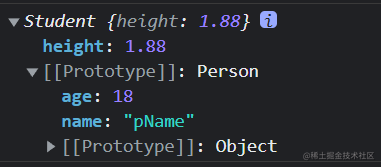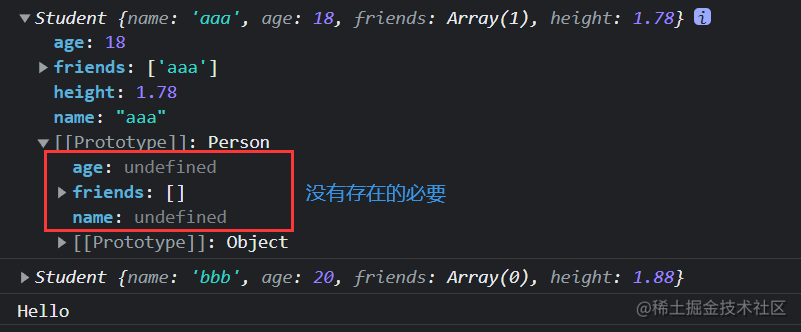实现instanceof
instanceof 运算符用于检测构造函数的 prototype 属性是否出现在某个实例对象的原型链上。
Object.getPrototypeOf() 方法返回指定对象的原型(内部[[Prototype]]属性的值)
要懂原型和原型链
function myInstanceof(target, origin) {
if (typeof target !== 'object' || target === null) return false
let proto = Object.getPrototypeOf(target)
while(proto) {
if (proto == origin.prototype) return true
proto = Object.getPrototypeOf(proto)
}
return false
}
console.log(myInstanceof("111", String));
console.log(myInstanceof(new String("111"), String));
class People {}
class Student extends People {}
const stu = new Student();
console.log(stu instanceof People);
console.log(stu instanceof Student);
|
JS如何实现继承?
方式1:借助原型链
function Person() {
this.name = 'pName'
this.age = 18
this.friends = []
}
Person.prototype.sayHello = function() {
console.log('Hello');
}
function Student() {
this.height = 1.88
}
let p = new Person()
console.log(p);
Student.prototype = p
let stu = new Student()
console.log(stu.name);
stu.sayHello()
|
这种实现方法存在的问题:
1.当我们打印实例stu的时候,继承的属性不能直观看到,只能在__proto__属性中看到

2.另外,如果我们创建两个实例对象,并改变friends属性
stu1.friends.push('aaa')
console.log(stu2.friends);
|
明明改变的是stu1的属性,为什么stu2也变了?
因为我们它们的隐式原型指向的是同一个对象,p
3.前面实现的过程都没有传递参数
方式2:借助构造函数
使用call调用构造函数,传入的this为当前实例,并且可以把参数传给父类处理
function Person(name, age) {
this.name = name
this.age = age
this.friends = []
}
Person.prototype.sayHello = function() {
console.log('Hello');
}
function Student(name, age, height) {
Person.call(this, name, age)
this.height = height
}
let p = new Person()
Student.prototype = p
let stu1 = new Student('aaa', 18, 1.78)
let stu2 = new Student('bbb', 20, 1.88)
stu1.friends.push('aaa')
console.log(stu1);
console.log(stu2);
stu1.sayHello()
|
构造函数的方法可以解决原型链方式的问题,但是依然存在弊端
- Person 至少被调用两次(一开始new Person一次,后面Person.call又会调用Person)
- stu的原型对象上会多出一些属性, 但是这些属性是没有存在的必要(new Person的时候的)

方式3:寄生组合式继承(最终方案)
**Object.create()**方法创建一个新对象,使用现有的对象来提供新创建的对象的__proto__。
Object.create(XXX) 也就是传入的对象XXX,作为新对象的原型
function Person(name, age, friends) {
this.name = name
this.age = age
this.friends = friends
}
Person.prototype.sayHello = function() {
console.log('Hello');
}
function Student(name, age, friends, height) {
Person.call(this, name, age, friends)
this.height = height
}
Student.prototype = Object.create(Person.prototype)
Student.prototype.constructor = Student
let stu = new Student('aaa', 18, ['fre1'], 1.88)
console.log(stu);
|

当然,我们也可以封装一个方法来继承父类prototype中的属性和方法
function inheritPrototype(SubType, SuperType) {
SubType.prototype = Object.create(SuperType.prototype)
Object.defineProperty(SubType.prototype, "constructor", {
enumerable: false,
configurable: true,
writable: true,
value: SubType
})
}
...
inheritPrototype(Student, Person)
|
JS柯里化实现
要求,传入一个函数,返回一个柯里化的函数
思路:当已经传入的参数 大于等于 所需要的参数时,就执行函数
没有达到个数时,需要返回一个新的函数,继续来收集参数,接收到参数后,递归调用curried来检查函数的个数是否达到
function myCurrying(fn) {
function curried(...args) {
if (args.length >= fn.length) {
return fn.apply(this, args)
} else {
function curried2(...args2) {
return curried.apply(this, [...args, ...args2])
}
return curried2
}
}
return curried
}
function add1(x, y, z) {
return x + y + z
}
var curryAdd = myCurrying(add1)
console.log(curryAdd(10, 20, 30));
console.log(curryAdd(10)(20, 30));
console.log(curryAdd(10)(20)(30));
|





